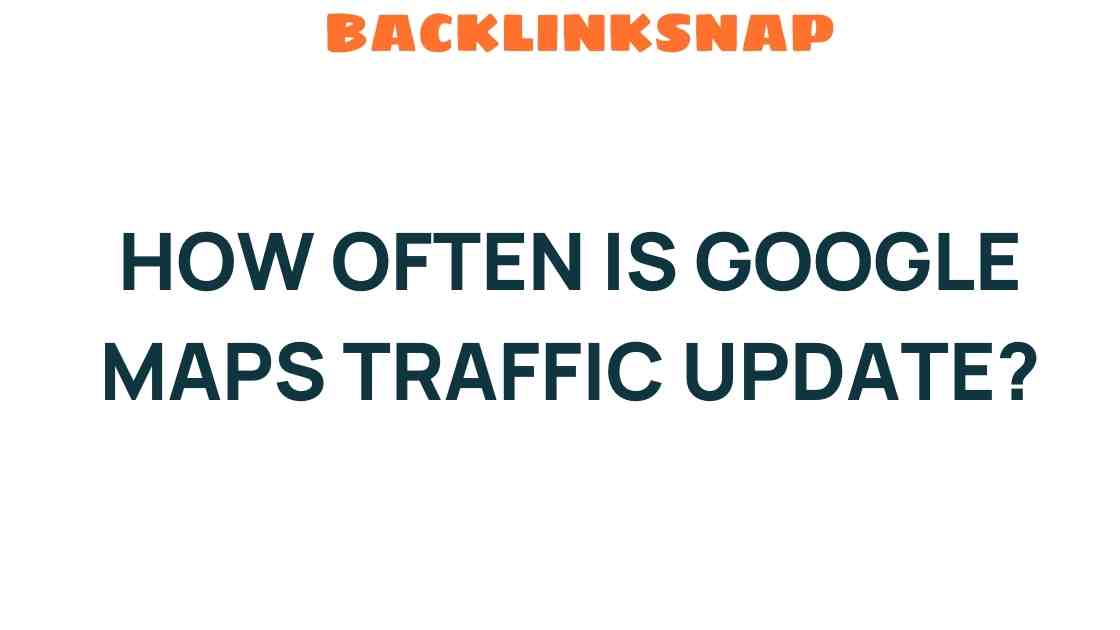How Often Is Google Maps Traffic Update?
In today’s fast-paced world, navigating through busy streets and highways can be a daunting task. This is where Google Maps comes into play, providing invaluable traffic updates to ensure smooth journeys. But just how often does Google Maps update its traffic information? Understanding this can significantly enhance your real-time navigation experience and help you plan your journeys more effectively.
The Mechanics of Google Maps Traffic Updates
Google Maps utilizes a sophisticated system that merges various data sources to provide the most accurate and timely traffic updates. This system relies heavily on location data gathered from users and other sources, creating a dynamic picture of current road conditions. Here’s a closer look at how it works:
- User Contributions: One of the primary sources of traffic data comes from users themselves. When you use Google Maps while driving, your smartphone sends anonymized location data back to Google. This data helps build a real-time map of vehicle speeds and congestion levels.
- Historical Traffic Patterns: Google also analyzes historical data to predict traffic behavior. By looking at past traffic patterns, they can estimate future conditions during similar times.
- Incident Reports: Google collects information about accidents, roadworks, and other incidents that may affect traffic flow. This data often comes from public agencies, news reports, and user reports.
- Satellite Imagery and Cameras: Google integrates satellite imagery and traffic camera feeds to enhance the accuracy of its maps. This additional layer of information provides a more comprehensive view of current traffic conditions.
Frequency of Updates
So, how often does Google Maps refresh its traffic data? The answer is continuously. Google Maps traffic updates are made in real-time, with updates occurring approximately every few seconds to minutes, depending on the area and the volume of incoming data. In urban areas with heavy traffic, updates are more frequent due to the higher density of users contributing location data and the rapid changes in traffic conditions.
This real-time capability allows Google Maps to provide not only current traffic conditions but also estimated travel times, which adapt as conditions change. For instance, if a new accident occurs, the estimated time of arrival (ETA) will adjust almost immediately based on the new data.
Importance of Map Accuracy
Accurate traffic updates are crucial for effective journey planning. Relying on outdated information can lead to unexpected delays, missed appointments, or even frustration. Google Maps aims to maintain high levels of accuracy through:
- Real-Time Data Integration: By continuously integrating new data, Google ensures that users receive the most accurate information possible.
- User Feedback: Google encourages users to report inaccuracies or provide feedback on traffic conditions. This user-generated content helps improve the overall quality of the data.
- Machine Learning Algorithms: Google employs advanced algorithms to analyze and interpret traffic data, improving the accuracy of predictions over time.
To make the most of Google Maps traffic updates, consider the following tips:
- Use Real-Time Navigation: Always opt for real-time navigation when driving. This ensures that you’re receiving the latest updates and can make informed decisions on the road.
- Check for Alternate Routes: Google Maps often provides alternate routes that can save time, especially if you encounter unexpected traffic jams.
- Stay Informed: Keep an eye on traffic alerts or notifications that Google Maps may push to your device, as they can provide timely information about accidents or road closures.
FAQs about Google Maps Traffic Updates
1. How does Google Maps know about traffic conditions?
Google Maps gathers traffic data from several sources, including user location data, historical traffic patterns, incident reports, and satellite imagery.
2. How often is traffic data updated on Google Maps?
Traffic data on Google Maps is updated in real-time, with updates occurring every few seconds to minutes, depending on the location.
3. Can I contribute to Google Maps traffic data?
Yes, when you use Google Maps while driving, your anonymized location data is sent back to Google, contributing to traffic updates. Additionally, you can report traffic incidents or inaccuracies directly through the app.
4. Does Google Maps work in rural areas for traffic updates?
While Google Maps provides traffic updates in many rural areas, the frequency and accuracy may be lower than in urban regions due to fewer users contributing data.
5. How does Google Maps predict traffic congestion?
Google Maps uses historical traffic data to identify patterns and predict congestion based on the time of day, day of the week, and current conditions.
6. What should I do if Google Maps shows unexpected traffic delays?
If you encounter unexpected traffic delays, you can check for alternate routes in the app or set Google Maps to alert you of changes in real-time.
Conclusion
In conclusion, Google Maps is a powerful tool that provides essential traffic updates to enhance your driving experience. By leveraging user contributions, historical data, and advanced algorithms, Google Maps ensures that you receive timely and accurate information for your journey planning. Understanding how often Google Maps updates its traffic data allows you to navigate with confidence, making your travel smoother and more efficient. So, the next time you hit the road, remember that Google Maps is there to help, guiding you through the twists and turns of traffic with real-time insights.
For more information on how to optimize your use of Google Maps, you might find this article helpful: Google Maps Tips and Tricks.
For the latest technology insights and updates, check out TechCrunch.
This article is in the category Digital Marketing and created by BacklinkSnap Team




